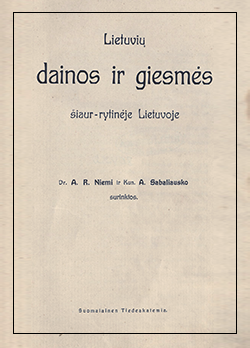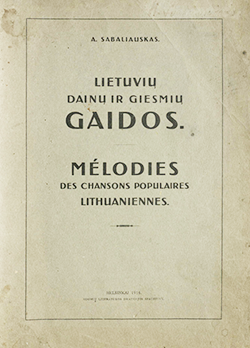|
Aukštaitija
Aukštaitija |
Dzūkija
Dzūkija |
Įrašų sąrašo rankraštis
Įrašų sąrašo rankraštis |
A. R. Niemio lietuvių tautosakos rinkinių paveldas
PrefaceFinnish professor Aukusti Robert Niemi (1869–1931) is truly a unique case in the history of our culture: during a historical period fraught with difficulties, he came to Lithuania, led by scientific aspirations, and for many years fostered cultural ties between Lithuania and his native Finland. He also participated in relevant political discussions of the period and contributed to the reform of the education system in Lithuania’s schools. As time went on, the legacy of his social and cultural activities fell into oblivion, yet Niemi’s contribution to the development of Lithuanian folklore always remained in the focus of researchers in the field of humanities. Particularly relevant is Niemi’s work that is still used in folklore research: his comparative research of songs and the folklore heritage that he collected, which is now presented in this electronic publication ( A. R. Niemio lietuvių tautosakos rinkinių paveldas / A. R. Niemi’s heritage of Lithuanian folklore collections). An electronic version of the folklore collection was the best option due to both its accessibility and the opportunity to present side by side not only the edited version, but also the authentic printed and manuscript versions. This is particularly important when the goal is to encourage this material’s reception in academic and cultural discourse. Short overview of the presented collections. A more detailed history of these folklore collections is available in the introductory article (see the section Iš rinkinių istorijos ). Here we will only recollect a few of the more significant facts related to the collections presented here. In the early 20 th c., folklore studies as a science had already formed in many European countries; in the works of folklorists from that period, comparative studies were prevalent. Therefore, it is no accident that Niemi, who chose folklore studies at Helsinki University (where the creators and representatives of the historical-geographical, or ‘Finnish’, method were gathered), also moved his research in that direction. He began comparative studies of songs, delving deeper into the source of Finnish songs and the possible influence of other nation’s songs. Lithuanian and Latvian folklore eventually entered the horizon of his scientific interests. An introduction to Lithuanian folklore, in the literal sense, began with studies of the Lithuanian language. In the summers of 1900 and 1902, Niemi came to Lithuania to learn the language and during that time, with help from his teachers, began to translate Lithuanian songs that already had been printed. In 1909, for a three-year period he received the Helsinki University Herman Rosenberg scholarship, which allowed him to immerse himself in serious comparative research. Two separate folklore collection expeditions were organised for this occasion. In 1910 – to north-eastern Aukštaitija, a year later – to Dzūkija (southern Lithuania). The material from these expeditions is held in the Folklore Archives of the Institute of Lithuanian Literature and Folklore. The number LTR 626 was given to the folklore collected along the northern borders of Lithuania, while LTR 626a – to the transcript made during preparations for publishing (1911). The collection of folklore from Dzūkija, which included over two thousand texts of folklore, was split into two archival collections – LTR 627 (the archive file of the collection’s transcript – LTR 627a) and LTR 628. Professor Niemi put in a lot of effort for the collected folklore to be published. Unfortunately, the public was only introduced to the material from the expeditions that took place in 1910. As we already know, this expedition was the starting point for Niemi’s acquaintance with Adolfas Sabaliauskas, who was a priest in Nemunėlio Radviliškis. Sabaliauskas originated from here and at the end of the 19th c. he had already begun to collect songs; when Niemi was visiting, Sabaliauskas had a collection of more than half a thousand. Having seen that both collections were very similar, the idea came to join them together and publish everything as a single work. Impetus to release the material from the expedition came from the unique songs, sutartinės, found in Aukštaitija, which until that time had not been more carefully studied by researchers. Aukusti Robert Niemi’s and Adolfas Sabaliauskas’ north-eastern Lithuanian song collection was published in 1912 [1]; this publication was financed by the Finnish Academy of Sciences. In total, 1,459 pieces were published, of which nearly 800 were sutartinės (published for the very first time), and 26 melodies were added at the end. The book, of which only 200 copies were given to Lithuania (by request of the Lithuanian Science Society), at that time had already become one of the key sources for Lithuanian songs and a part of the cultural self. In this stage of the work, these were the key arguments for representing the folklore, written down in northern Lithuania, with a published collection, not manuscripts. It was also taken into account that the publication presents the material in a classified manner; in addition, the printed work is supplemented with references to the manuscripts of both Niemi and Sabaliauskas, if there would be reason to believe that the version could be useful for scientific research. In addition, some of the song texts (315) from this publication can be supplemented with the melodies from A. Sabaliauskas’ book, Lietuvių dainų ir giesmių gaidos [2]; here we can find the melodies of 635 songs and instrumental music as well as the texts to 318 unpublished songs. This electronic format allowed to link together texts and melodies available in different publications and present in a more convenient manner such books that are a bibliographical rarity and are not easily available. The collection of folklore from Dzūkija was not destined to become a published work, although the professor did have plans to publish it separately. Preparatory work began immediately after the expedition (in 1911). However, preparations took longer than expected. Niemi came back to his idea of publishing songs from Dzūkija towards the end of his life, in the spring of 1931, having received the approval and financial support of the Finnish Academy of Sciences. Unfortunately, the professor died in the autumn of that same year and the Dzūkija folklore collection was never published. Today, the whole of this collection can only be recreated through the transcripts made as it was being prepared for publication (around 1911) – part of the expedition’s manuscripts clearly did not make it to the Lithuanian Folklore Archive. The original manuscript is held in the collection LTR 627, with some reservations, making up around 1,000 units of folklore (1–1,000); the rest of the collection is represented through transcripts – in collection LTR 628, which continues the numbering begun in Niemi’s collection, i.e. it begins with 1,001. The sheaf of the original manuscripts for collection LTR 628 (comprised of 141 texts), to this day have not been formally presented and only gained the status of archival document, as file LTR 628a, when this electronic publication was being prepared. This could be a brief explanation regarding the confusion why the original manuscript from the 1911 expedition is represented by the archival collections LTR 627 and LTR 628a. Collections LTR 627a and LTR 628 are comprised of transcripts. In the historiography of folklore and the tradition of the preparation of sources in Lithuania, both the manuscript from the expeditions and its transcript were given the status of ‘reliable sources’, without even considering possible complications in regards to the form of the collection. However, textological analysis of collections LTR 627 and LTR 627a, LTR 628a and LTR 628, allows us to state that giving Niemi’s collection transcript the status of reliable source was done so without basis − without taking into account that the difficult-to-read texts recorded by this foreigner and his helpers, who had no experience in writing down songs, were later rewritten by people with just as little experience. In order to reflect the whole of the Dzūkija folklore collection as an important document for Lithuanian folklore, this publication presents all of the digital versions of the LTR 627, LTR 628a, LTR 628 collections. The transcript of collection LTR 627 (LTR 627a) is not published as an independent document – rather the information on the links between the original work’s recording and its transcript (if it has been preserved), as found in the description of the contents of archival collection LTR 627. Pieces no. 937–961, preserved in collection LTR 627a and available only in transcript form, are included in the table of contents for LTR 627, this way presenting the reader with the opportunity to form a broader (such as a genre-based) view of the the entire collection of folklore from Dzūkija. The publication’s structure, presentation of the data. Readers can see, page by page, digital versions of the printed and handwritten collections, just as they would read real books and archival documents. The second option for presenting the collection would have been to use the tables of contents prepared by the authors (see the section Įrašų sąrašas ), where a separate entry was created for each piece. Here, a scanned image of the work is presented, while in its description – the text, which is adapted in line with a set editing criteria, excluding those parts of the original manuscript and collection LTR 628 (held as transcripts) that are hard to read and there are doubts regarding their credibility. Each piece’s description also presents the relevant information on it – data on the presenter, who wrote the piece down, location and date, notes, as well as links to other pieces (if such exist). The forms of the nominals are presented in the same way that they were recorded in the manuscript and printed collection. Surnames in the collection of folklore from Dzūkija, as collected by Niemi and his assistants, are checked; when necessary, they are edited taking into account the various surnames of this region that can be found in other kinds of sources. The location where the piece was written down is identified based on Lithuania’s modern administrative division, albeit presenting also the information recorded in the primary source. Since data on the sources and recording locations were not copied to the transcripts, which were made for the purpose of editing the texts and classifying the material, they did not survive and are not reflected in the description of the pieces included in archival collection LTR 628. In creating the tables of contents for the digital versions of the collections, the sequence and numbering of the published and manuscript collections of folklore from Dzūkija was retained. There is basis to believe that the manuscript collection LTR 627 includes transcriptions from other sources (no. 1018–1274a); as non-authentic material they are presented not with separate entries, but in certain blocks, taking into account the location where they were written down, who wrote them down, and the established authentic source (such as Mįslės iš Pušaloto apyl. [Riddles from Pušalotas district]). In preparing the table of contents, the first lines of text were selected as the song title; the titles for laments were the beginning of the text followed by an ellipsis; for ethnographic descriptions, stories, sound imitations, games, instrumental folklore – the titles were created by the collection’s authors and written in square brackets; if the manuscript’s text was indecipherable, an ellipsis is placed in square brackets. Editing decisions, presentation of the texts. The nature of the sources was the basis for the different editing criteria for the published and manuscript texts. In the early 20 th c., when publishing Lietuvių dainos ir giesmės šiaur-rytinėje Lietuvoje as well as Lietuvių dainų ir giesmių gaidas , Sabaliauskas, an amateur folklorist who had no prior experience in editing dialectic texts, not only had to step off the beaten path but also find a way to publish the material recorded by Niemi and his helpers in an almost literary form. It was decided to unify the dialects of texts that had varied dialect forms. In this publication we don’t offer new, substantially edited versions of the published texts. However, in order for them to be accessible to a larger circle of readers, the dialectic phonetics were changed to standard language phonetics. Although rarely, there are still cases of correction where it is possible that the recorder and/or editor made a mistake (for example, ‘Rūta, mėtra, peletrūna, Trinytėla pelė ’ was changed to ‘Rūta, mėtra, peletrūna, Trinyti lapeliai ’). Punctuation is edited taking into account modern practices for publishing songs. The structure of the verses remained unchanged; in order for them to be easier to read, the verses are separated from each other with a space. The manuscripts of the folklore from Dzūkija and the editing decisions related to their presentation require a more in-depth commentary. A great deal of this material was written down by Professor Niemi himself; his native language and his Lithuanian skills, insufficient for this type of work, left their mark in the manuscript. His assistants also didn’t have experience in writing down folklore texts. Therefore, after becoming acquainted with the difficult-to-read style of the collection, the first task was to deal not with issues of editing the texts, but to decipher them first – sometimes in the literal sense of the word. It isn’t easy to simply describe the unique features of this Finnish researcher’s way of recording texts: he consonants are muddled, their softness or hardness isn’t reflected, long and nasal vowels are not marked, etc. (‘Mano zeba ’, should be ‘Mano ciba ’, ‘Stovi grusele , žalia upelele ’ – ‘Stovi grūšelė , žalia obelėlė’ ). There are many both obvious and not so easily predictable phonetic errors as a result of being unaware of the Lithuanian singing tradition (for example, ‘Nuvediau šieną audzia ’ should be ‘Nuvediau šienaucia ’, ‘Mano motulelis nei bagota’ – ‘Mano motulė lyšniai bagota’). Such errors are corrected on the basis of other versions of the songs or with the help of the Lietuvių kalbos žodynu [Lithuanian language dictionary]. If the mistakes are clear and their corrections raise no doubts, the reconstructed parts are not marked in the text. If there are no reliable sources, then the proposed correction is marked with a question mark in parentheses. The reconstructed part of the text (usually a word or line) is marked with square brackets. In order to not stray too far from the manuscript, the edited version attempts to reflect the text as it was recorded. Solid lines and dashed strokes marked in the manuscript larger parts of text that had been omitted – in the edited version they are marked with a dashed line. Phrases like ‘ ir t.t.’ [and so on], related to larger blocks of text, are kept; when they indicate a repeated refrain, an ellipsis is written after the first phrase of the refrain. In the manuscript, the repetition of the line of the song or part of the song was reflected in various ways. In addition, the repetition of lines is not always clearly marked. Therefore, in the edited text they are corrected, sometimes without being reflected at all. Unlike in the manuscript, the song lyrics are in verses. Punctuation is dealt with in line with modern rules, taking into account the norms established publishing songs. From the aforementioned issues, we can draw the conclusion that in the publication it would be no easy task to come as close as possible to the authentic form of the texts. This is why the phonetics of standard language, conveyed through the regular alphabet, is applied to the texts, Consistent efforts are made to maintain only past simple tense first person singular and past tense feminine active participle, without affricate consonants – this is seen as one of the more characteristic features of dialect and is quite well-reflected in the manuscript ( šluostiau – šluosčiau [I swept], matius – mačiusi [had seen]). The norms of standard language are used in correcting the muddled vowels and consonants in the manuscript – such corrections are not marked. The tendency is to maintain the morphological properties. Only cases that do not significantly affect the poetic sound of the song and which were inconsistently written down are transposed into standard language. Different forms of the same word (such as čiulbėti [to warble] and čilbėti, džiovyti [to dry] and džiovinti ) are made the same only in single song. Adverbs like kodėl, todėl, kaip, taip, kada [why, because, how, so, when], the conjunction nors [although], are transposed into the standard language from their dialectic form. When the word’s form is shortened in an abnormal way, an apostrophe is written ( kol ’ – kodėl [why], man ’ – mane [me]). Less common features of dialects are not described in extensive detail, although noting that in a situation where it was difficult to read the text, there were issues in avoiding subjectivity when editing. The virtual publication of A. R. Niemi’s folkloric legacy is presented by the following folklorists from the Institute of Lithuanian Literature and Folklore: Vilma Daugirdaitė (author of the introduction, prepared the material for the folklore collection from Dzūkija), Jurgita Ūsaitytė (prepared the published song collections), Andželika Jakubynienė, Eligija Garšvienė, Asta Skujytė-Razmienė, Rima Visackienė, Irena Žilienė (digitised the published and manuscript collections). Programmer: Arūnas Ciesūnas. Preface translated into English by: Gabriella Žičkienė. Reviewed by: Dr. Bronė Stundžienė, Dr. Saulė Matulevičienė. We would like to thank the Lithuanian Council for Culture, which partly funded the project A. R. Niemio lietuvių dainų rinkinių skaitmeninimas ir duomenų bazės sukūrimas (Agreement No S/ETN-3(6.23)/2017). The cover uses a photograph from the Folklore Archives of the Institute of Lithuanian Literature and Folklore (LTRFt 22326).
Vilma Daugirdaitė
[1] Lietuvių dainos ir giesmės šiaur-rytinėje Lietuvoje, , Dr. A. R. Niemi ir kun. A. Sabaliausko surinktos, [Helsinkis (Ryga)], 1912. [2] A. Sabaliauskas, Lietuvių dainų ir giesmių gaidos, Helsinkai, 1916.
| ||||




